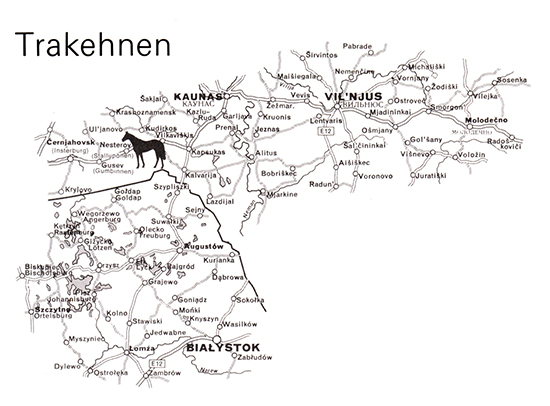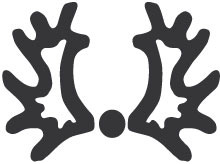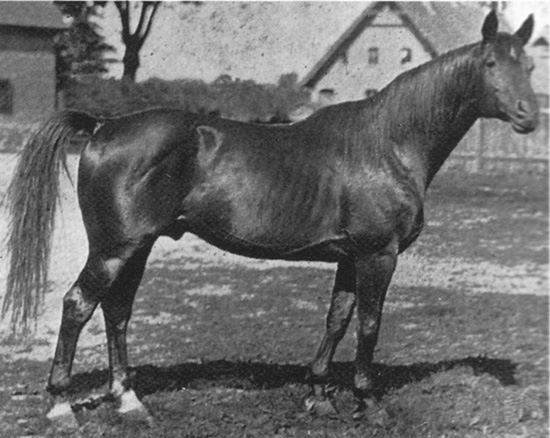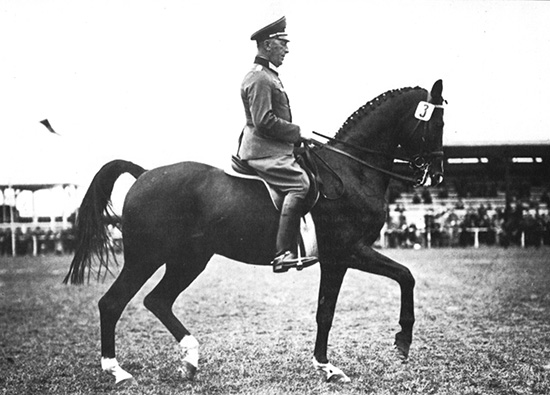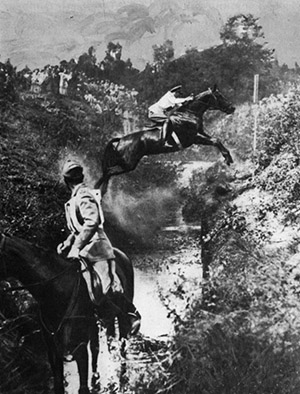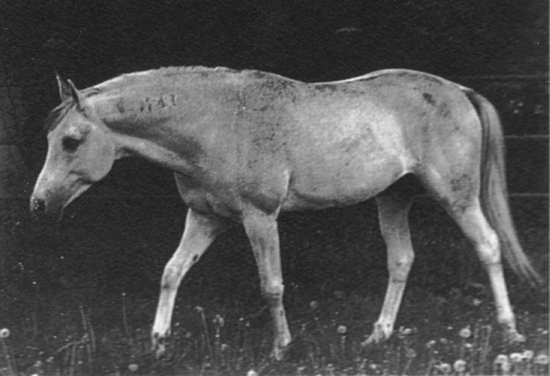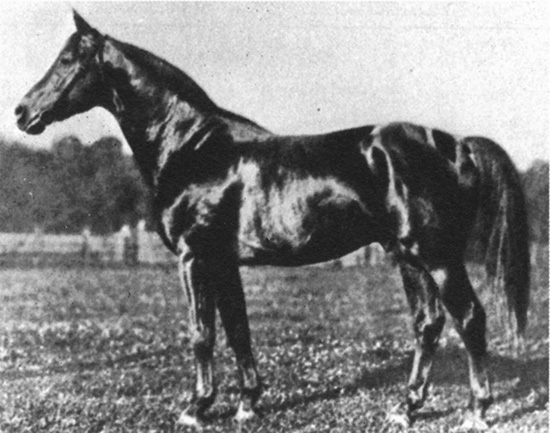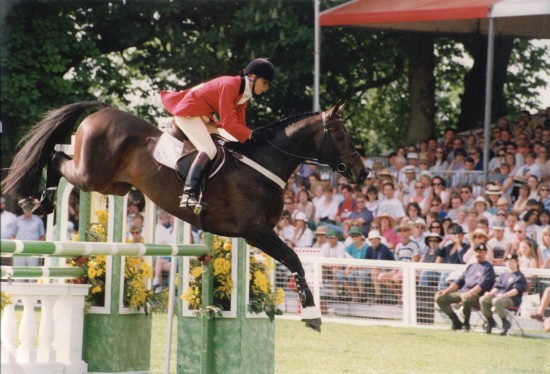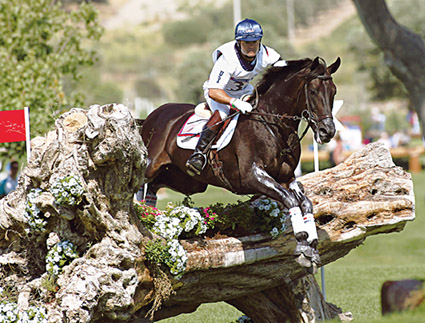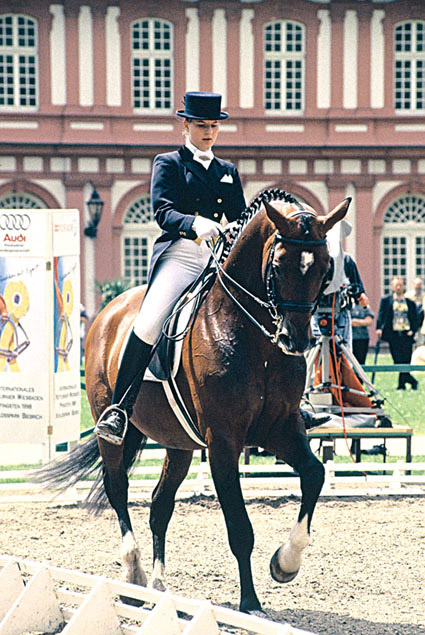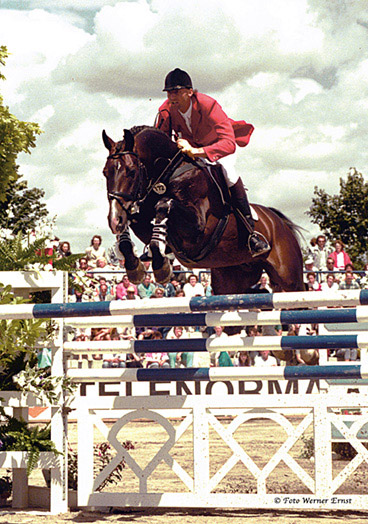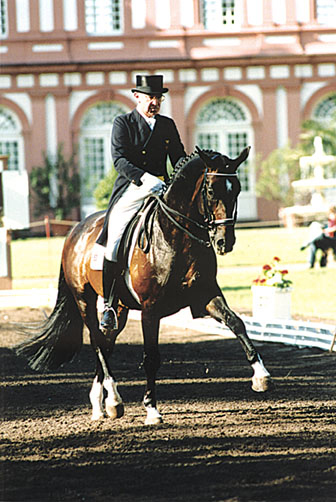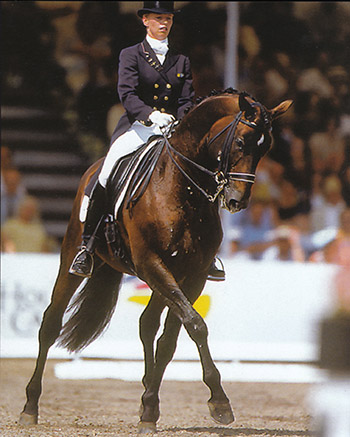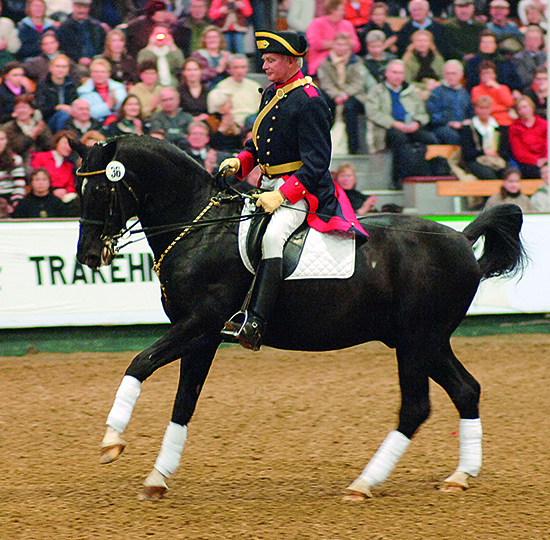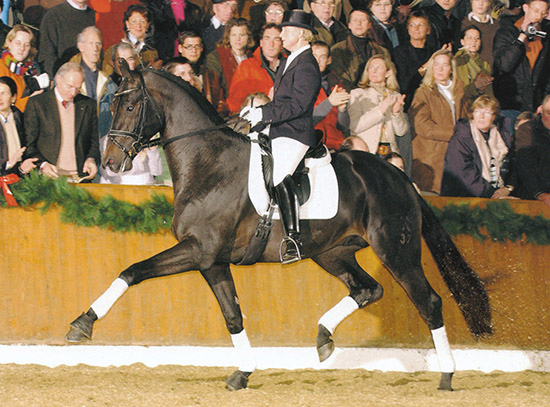Trakehner breeding originated in East Prussia in the thirteenth century when the Teutonic Knights colonised the land – and with it the hardy local Schweiken horse.
In 1732 the Friedrich Wilhelm II ordered the establishment of the Royal Stud at Trakehnen. The early products were not impressive and in 1787, the newly appointed head of the stud, Graf Lindenau culled 25 of the existing 38 stallions, and 144 of the 381 broodmares, remarking that they were ‘not lean and strong boned enough, moved too narrow in the hindequarters and there were too many curbs; some horses were eliminated because they were suspected of having spavins and some had boxy hooves.’
Graf Lindenau also opened up the stud, transforming it from a royal stable, to a centre for horse breeding for the whole of Prussia. The local farmers could now send their native mares to the stallions at Trakehnen – and the area became the major source of supply for the army for the next 150 years. Right from the start, large numbers were bred, with 7324 mares approved in 1796 alone.
During the nineteenth century, Linedenau’s policy of using only Arab and Thoroughbred blood was continued, and by 1860, some 15,559 mares were bred to Trakehner stallions of whom 68.4% were Thoroughbred. By 1912, there were 48,467 mares, and 84% of the stallions were Thoroughbred.
The Anglo Arab, Thunderclap, by the Thoroughbred, Mickle Fell, stood at the central Trakehnen stud and was a strong influence in the nineteenth century
Tempelhüter was born in 1905, and stood at stud from 1909 t0 1932 – he was considered the ideal type of Trakehner
Suddenly the main market, the cavalry, literally disappeared when under the terms of the WW1 Armistice, the German army was limited to 100,000.
Individual silver and team gold at the 1936 Olympics for Absinth and Major Friedrich Gerhard
And team and individual gold in the eventing at the 1936 Games for another Trakehner, Nurmi
The breeders in the 1920’s and 1930’s swung to producing a heavier dual purpose horse, sired by stronger part-Thoroughbred stallions. But still there was something different about the Trakehner. German equestrian journalist, Jan Tönjes explains:
“In those pre-WW2 years hardly any of the other famous studbooks of today focused on the production of sport horses. Holstein and Oldenburg kept their eyes on coach horses and on working horses, Hannover was producing horses for the cavalry and Westphalian farmers would collapse with laughter at the suggestion of breeding horses with only one purpose, namely to put a saddle on and ride either dressage or even jump over fences. If there were horse shows in the 1940s then the broodmares that day-by-day pulled carts or ploughs would have to serve as show horses on weekends. In 1936 the Olympic Games took place in Berlin and Trakehners won six gold medals. Kronos and Absinth won individual gold and silver medals in dressage and Nurmi was the Olympic champion in Three Day eventing. Pure-bred Trakehner horses can only have Trakehner, Throroughbred, Anglo-Arab or Arab parents. This concept made the horses unique among all other Warmbloods in Germany, most of whom were at some stage in their history bred for agricultural rather than equestrian pursuits.” (The Horse Magazine, March 2006)
One of the Arabs who stood at Trakehnen between 1936 and 1944, Fet7sz OX – his line continues through his grandson, Maharadscha…
Performance testing of stallions was key to the program and in 1926 a stallion testing station was established at Zwion. The three year old stallions were tested over a three-day cross country test and the stallions were prepared in the famous Trakehnen hunts across the formidable fences of the estate.
Dampfross was foal in 1916 and stood at Trakehnen from 1923 to 1934 – a classic Trakehner
In 1944 in the face of the advance of the Russian Army, the Trakehnen stud was abandoned – stallions, broodmares and youngstock were loaded on to west bound trains, while the East Prussian farmers harnessed their broodmares to carts and headed west. Some perished on the way, some were left behind as the group moved, eventually only about 1600 horses out of the original 27,000 made it to the newly formed West Germany. During the next two years, the numbers fell further until there were only 700 mares and 60 stallions – and no foals.
In 1947 Germany’s first national (as distinct from breeding district based) studbook was formed, the Association of Breeders and Friends of the Warmblood Horse of Trakehner Origin – the Trakehner Verband.
The following 40 years saw a huge revival of the Trakehner breed, and by the 1990’s there were some 1400 foals per year being registered in the West Germany. In 1987, there were 3410 Trakehner broodmares, served by 301 stallions. Ten years later, there were 5068 mares, and 234 stallions. Since then there has been a slight decline in Trakehner numbers – in 2007, there were 3573 mares and 222 stallions. The Auction figures represent steady progress: in 1987, the average price for a licensed stallion was €23,264 and the average mare price, €7,948. By 1997, the stallion average was up to €51,384 and the mare average at €13,692. In 2007, the stallion average was €61,800, while the mare average was €13,167.
In 2013, we see that the decline – which affects all breeds and all breeding areas – continues. The number of mares had shrunk to 2,909, and the number of foals, to 938 – with 1,298 mares covered.
However the Trakehner auction prices hold their value – in 2014, the average price for a licensed stallion was €63,900, and the average price for mares, €23,600
Source: “Trakehner Hefte”, official publication of the Trakehner Verband
Still there were twists and turns along the way, and at one stage it looked as if the Trakehner breed had totally lost its focus. Once again, it is Jan Tönjes, well-known as a friend to the Trakehner, who makes the point:
“Trakehner breeding politics definitely took the wrong path in the 1970’s. The idea of having something special led to a false goal – beauty. It was no longer performance that was important but beauty. More and more Trakehner breeders concentrated on beautiful faces, straight limbs and forgot about things like rideability or jumping ability.”
“By the end of the 70’s some of the wiser Trakehner breeders realized this was a problem – maybe as serious as the situation after World War II. Stallions with weak toplines, flat movements and no eagerness to work became extremely popular. If the progeny of these kind of fashionable stallions would refuse to work then Trakehner breeders would often blame the problem on the rider: ‘He’s just not able to ride something so special and sensitive as a Trakehner.’ One of the biggest problems was stiff legged movement without any knee action. Horses that move very flat, more like skaters than the dancers required in the dressage ring.”
“Stiff and beautiful were the distinguishing features and no other Warmblood breed was interested anymore in the Trakehner horse. At the same time, the number of sport riders looking especially for a Trakehner declined, since with the decline of the Trakehner breed, came the rise of other Warmblood breeds such as the Westphalians, Oldenburgs, Hanoverians or Rhinelands. The absence of jumping ability in the Trakehner breed became proverbial in the 1980’s, no matter how high and well Abdullah jumped.”
It was in the 90’s that the bad reputation of Trakehner horses as poor perfomers changed. Slowly but surely the number of Trakehner horses doing well increased – especially in dressage and eventing.
Eventer Peter Thomsen rode the grey mare, White Girl in the bronze medal winning team at the 1994 WEG and for the first time a horse competed with the suffix TSF which stands for Trakehner Sportpferde Foerderung, a club designed to support Trakehner horses in sport and to bring together promising young horses and good riders at an early stage.
A great competitor and a very good sire, Yarlands Summersong
For France another Trakehner starred, Marie-Christine Duroy’s Summersong by Fleetwater Opposition (himself an eventer at three star level and for more than a decade the leading sire in the UK for producing eventers). The Kiwis who did so well in eventing had Jaegermeister II by Polarschnee (a Trakehner stallion, who was imported to Australia in the 1980’s) with Andrew Nicholson in the Bronze winning team in Atlanta.
Darren Chiacchia who bought the horse from Ingrid Klimke, with Windfall, USA, 3DE Athens 2004
In Germany it was Windfall with Ingrid Klimke when the pair qualified in dressage and eventing for the Bundeschampionate. Ingrid had successfully campaigned his sire, Grand Prix (by Swazi xx) in CCI***s. Marina Koehncke was a member of the German team for the WEG in Rome on Boettcher’s Longchamps by Sir Shostakovich xx. This was fairly impressive given that there not more than 1000 – 1200 Trakehner foals born each year.
Peron TSF leading the dressage charge with Michelle Gibson
The Trakehner breed was also well represented in dressage, with a number of stallions successful in international competiton. In the mid 90’s Peron TSF (by Mahagoni) led the change. The stallion had been exported to the USA after the stallion licensing, and re-appeared under the saddle of Michelle Gibson for team bronze medal and a 5th place individually at the Atlanta Games. Another was Heuriger by Herzbube who, ridden by Ellen Bontje, took out team Silver at the 1994 WEG in The Hague and an individual 5th place. Heuriger was named world’s most successful dressage stallion, some feat given that Donnerhall was part of the German team in The Hague.
The Trakehner also gained more than any other German breed from the fall of the Wall. When Germany was re-united in 1989, the Trakehner breed was boosted by the old Trakehner lines from the main stud in East Prussia.
A jumping Trakehner, Almox Prints
The Trakehner horses that were bred in former East Germany showed real jumping talent. Almox Prints by legendary Prussian sire Hockey took part at the 1988 Seoul Olympics and the 1992 Games in Barcelona. He also won the Grand Prix of Rotterdam and Wiesbaden and a small number of breeders took the chance to get outcross genes and jumping ability. On the KWPN Jumping Stallion breeding index for 2007-8, Almox Prints is in 9th place on the standings for mature stallions.
Biotop and Dr Klimke
For dressage breeders it was Biotop, the last Grand Prix horse of the late Dr Reiner Klimke. Biotop (whose dam is by Hockey) sired Shakira who in 2003 was named German champion mare. So far two of his sons, Goldschmidt and Monte Castello, are licensed.
Anky and Partout
Anky van Grunsven’s TCN Partout by Arogno is another dressage stallion with international wins, although he lived in the shadow of stable mate, Bonfire. His son Monteverdi, competed for a while with Fie Skarsoe, and is now a popular stallion. For a while it seemed a Trakehner horse, Monica Theodorescu’s Renaissance Fleur TSF (by Tuareg) was about to grab one of the prestigious places in Germany’s dressage team. Then, only two days after winning the Neumünster World Cup qualifier in 2003, the grey mare broke her leg!
One of the most ‘hyped’ stallions on the international scene has been Gribaldi (by Kostolany). He was purchased by Dutch stallion keeper, Joep van Uytert, and immediately the glossy ads and brouchures proliferated. Dozens of his progeny made it to the World Championships of Young Dressage horses. Painted Black, Anky’s up and coming Grand Prix horse, runner up at the World Championships (only beaten by fabulous Poetin) is also a son of Gribaldi. Edward Gal has many international top placings at prestigious shows with Gribaldi.
Kostolany and Otto Langels
Let Jan Tönjes take up the story: “As a colt Gribaldi was discovered by Otto Langels of Haemelschenburg stud. Langels is well known for his breeding policy that doesn’t necessarily goes hand in hand with what is in vogue at the moment. Himself a Grand Prix rider, Langels was never fond of the small handsome and beautiful Trakehners so popular in the 70’s and 80’s. Horses bred at his farm are mostly not so refined. And Kostolany, Gribaldi’s sire, is no exception from this rule. The black was champion stallion in 1987 and owes a lot of his popularity not only to his offspring that show various talents (Grand Prix dressage horses, eventers and 1.50m showjumpers) but to the fact that Langels perfomed the equine version of the ‘Phantom of the Opera.’ To the music of Andrew Lloyd Webber, Kostolany would not only do piaffes and passages but also sit and lay down. When the show was first presented at the Equitana the audience was thrilled. In the past 20 years Kostolany has covered more mares from the Trakehner breeding programme than any other sire. Via different sons he is grandsire to two champion stallions, Farinelli and Freudenfest.”
“Gribaldi’s best offspring in Germany is Hofrat, runner up at the 2000 grading and sire of the 2005 Hannoverian champion stallion Hotline (out of a De Niro dam). The gorgeous dark bay, Hotline, is of a different kind. His movements are outstanding, his willingness to work unbelievable. When Paul Schockemoehle and Danish premier stud Blue Hors decided to join and bid €800.000 for Hotline, Germany’s horseworld was turned upside down. 800,000 euros – unbelievable! The following February, Hotline was shown the first time under saddle. Even experienced breeders couldn’t believe their eyes. Totally relaxed with maximum activity from behind, the Hannoverian champion took his laps. The people in the stands were so thrilled that they forgot to applaud! Of course the Trakehners are also proud of Hotline because they always see the improvement of Warmblood breeds as part of their breeding philosophy. And if Paul Schockemöhle who never made a secret out of his general distaste for Trakehner horses buys such a horse, then the Trakehners must have changed.”
Hotline – Trakehners have changed…
Tönjes finished his survey in The Horse Magazine, on an upbeat note: “No matter in what directions Germany’s breeding policy may go, one thing is for sure: The Trakehner horse is here to stay. Within all the other breeds Trakehner are gaining more respect than say, 15 years ago. With performance, not beauty, being the emphasis, the Trakehner horse has managed to improve its reputation and the number of breeders thinking about using a Trakehner stallion or at least one carrying the famous bloodlines from East Prussia, is increasing. The way back to the top where the Trakehner once was may be long but the direction is clear. So here you go, Trakehner horse!”


